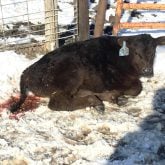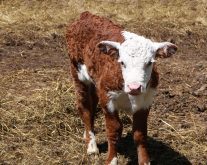Jane’s desperate phone call came after school Monday afternoon. She had noticed something different with Sisco last night when she groomed him. Sisco, a Welsh-cross, failed to eat his oats, seemed restless and wanted to lay down. Getting up when urged became difficult.
Her hunch something might be seriously wrong with her new pony turned out to be more than a gut feeling. What Jane saw when she opened Sisco’s box stall door frightened her. In a panic, she called the clinic. “Can you come right away? Something is seriously wrong with Sisco.”
In answer to several questions over the phone, indications were Sisco had developed a serious central nervous system issue. Symptoms included being unable to stand without leaning against a wall, head pressing, reluctance to eat, changes in behaviour and elevated temperature. Sisco’s clinical signs indicated an encephalitis, probably one transmitted by mosquitoes. I warned Jane to be careful until I could get there, as infected horses often become clumsy and can injure handlers inadvertently.
Read Also

Diagnosing and preventing lump jaw in beef cattle
Causes, symptoms, treatment, prevention and prognosis of lump jaw in beef cattle
Through the mid-1970s in mid-to-late summer, we saw several cases of Western equine encephalitis. For some reason, pony-types were mostly involved. All partially recovered with neurological deficits left behind: stumbling in sharp turns, behavioural changes and gait issues. I carefully outlined potential problems with each case.
The most common equine encephalitic viruses are Eastern equine encephalitis, Western equine encephalitis and Venezuelan equine encephalitis. They are collectively known as the equine encephalitides. All are transmitted by mosquitoes. Birds and snakes act as reservoirs of infection.
Western equine encephalitis is spread primarily by the vector mosquito Culex tarsalis. Other mosquitoes (e.g., Aedes species) have been known to spread the virus. C tarsalis is a mosquito that often is found on the Prairies and west coast of the United States. The mosquito prefers warm, moist environments. Horses and humans are both susceptible to Western equine encephalitis. Outbreaks of Western equine encephalitis virus infections (1930s-40s) resulted in significant numbers of deaths in horses and humans. Survivors often had permanent neurological impairment, which affected many teams used as the primary source of power on farms at the time.
In the last decade, West Nile virus entered the cluster of viruses causing equine and human encephalitis in North America. It was originally found in New York and then transmitted into northern reaches by migrating waterfowl and corvid species (crows, magpies, jays).
The clinical signs of Western equine encephalitis include depression, anorexia, lethargy and fever. Neurologic signs can include tremors, convulsions, paralysis, weakness, ataxia, inco-ordination, and recumbency.
Western equine encephalitis is diagnosed through bloodwork. Testing can include enzyme-linked immunosorbent assay (ELISA) or polymerase chain reaction (PCR) on cerebrospinal fluid (CSF) samples to identify the virus.
There is no cure for Western equine encephalitis. Treatment largely consists of supportive care for horses with clinical signs, including intravenous fluids and anti-inflammatory medications.
The American Association of Equine Practitioners recommends the Western equine encephalitis vaccine as a core vaccine. Good vector control is also important to protect your horse. Use insect repellents and keep horses in at night when mosquitoes are most active. Eliminate mosquito breeding grounds such as standing water, brush piles and old tires.
Because of potential long-term neurological deficiencies, Jane decided to put Sisco down. The beautiful pony met a tragic end to a vector-born disease preventable through vaccination. c
Dr. Ron Clarke is a veterinarian who consults on animal health and disease issues and writes for agricultural and veterinary audiences.

















